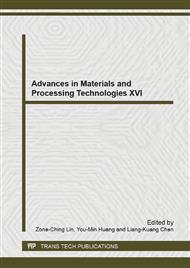p.138
p.146
p.152
p.161
p.169
p.177
p.186
p.194
p.201
Application of Idling Stop Technology for Servo Motors in Machine Tool Operations to Reduce Electric Power Consumption
Abstract:
Recently, with regard to global warming energy shortage, the saving energy has become a global issue. The demand for variety, variable production, high speed, high accuracy, and complex processing in the manufacturing fields has been emerged. Furthermore, automatic extinction of computer numerical control (CNC) screens and automatically hold of oil pressure pump in idling has been raise to do on research. On the contrary, there are few reports dealing with reducing power consumption based on existing machining tools system. The method presented in this report can be applied to various size and weight of machining tools. The experimental result of standby power and minimum power with emergency stop circuit of various machining tools is discussed in this research work. To expand the stage of the proposed method, a brand new system is developed. As a result, power consumption of a machining tool with the phase of idling can be effectively reduced through emergency stop circuit. By activating emergency stop circuit, power consumption can be equalized with the condition of main power-ON only. The standby electric power increases along with increasing weight of machining tools. Through the proposed original system, it is possible to set switching of servo ON and OFF to each section. Consequently, the methodology would be applied into many fields of precision processing.
Info:
Periodical:
Pages:
169-176
Citation:
Online since:
May 2014
Authors:
Keywords:
Price:
Сopyright:
© 2014 Trans Tech Publications Ltd. All Rights Reserved
Share:
Citation:


